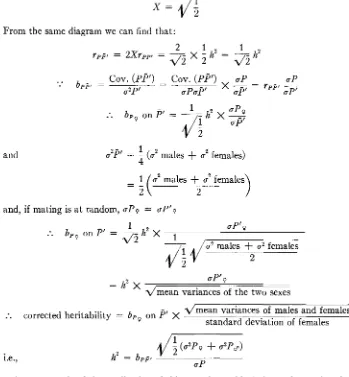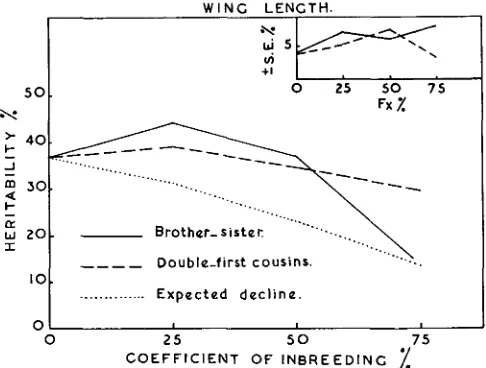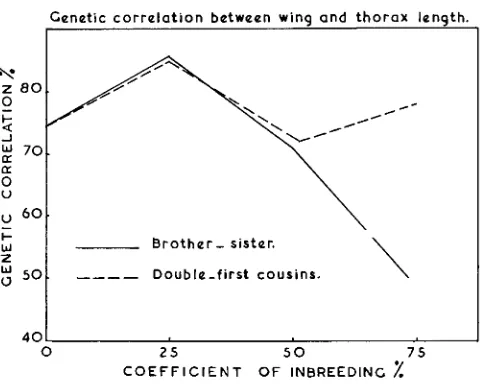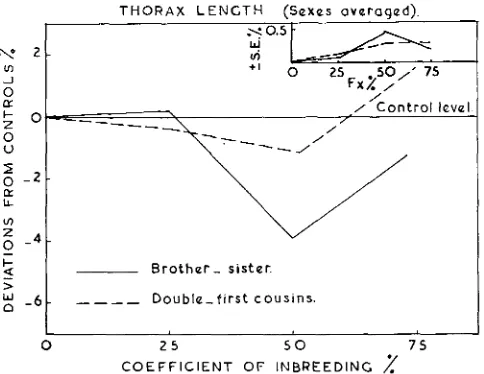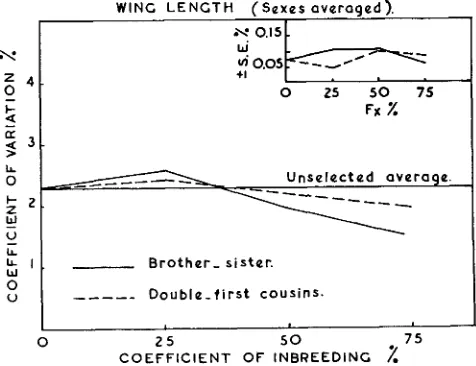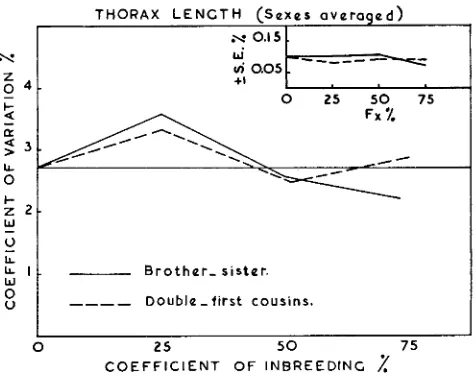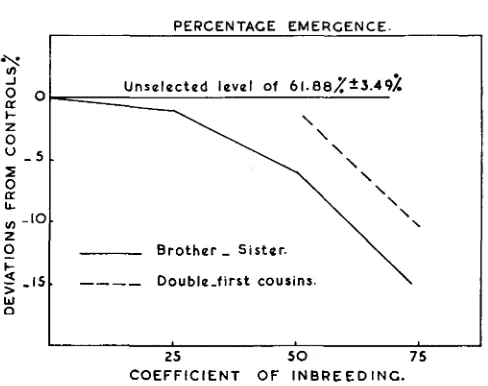GENETIC VARIANCE OF RAXDON-INBRED LINES OF DROSOPHILA MELANOGASTER I N RELATION TO COEFFICIENTS OF INBREEDING
A. 0. TANTAWY
Faculty of Agriczilture, Unioersity of Alerandvia, Alenandvia, Egypt
Received August 28, 1956
chief genetic effects of inbreeding is to decrease heterozygosity and the ex- mated individuals. WRIGHT (1921a) has been able to calculate theoretically the rate a t which heterozygosity is reduced. Therefore, it should be possible to calcu- late how many generations must elapse before the same degree of homozygosity is achieved under different systems of mating. Thus, in the absence of selection, fifty per- cent of the original heterozygous loci will be homozygous in the third and the eighth generations in matings between brother-sister and double-first cousins respectively.
Genetic variance of a given character is reduced by inbreeding because of the increase of homozygosity within inbred lines. Therefore, animal breeders correct the estimates of heritability, i.e. of genetic variance, derived from more or less inbred populations, to give a better estimate in non-inbred populations as shown by LEKXER (1950).
TE
tent to which this happens depends on how close is the relationship between theThe validity of such forecasts depends on:
1. Equal survival ability of homozygotes and heterozygotes; if the latter are favoured by natural selection, then the actual increase in homozygosity will be less than expected.
2. Negligible frequency of mutations which increase the variability during in- breeding.
3. Recognition that adjustment of heritability estimates based on inbred popula- tions is based upon the assumption that the genetic variation responsible for the observed heritability is strictly additive in nature.
WRIGHT (1920, 1934a) analyzed the total variance of white spotting and of poly- dactyly respectively in guinea pigs, inbred by brother-sister matings for more than twenty generations. He found that the genetic variability of both characters was almost eliminated in the highly inbred lines. ~IACARTHUR (1944, 1949) reported changes in heritability in lines of mice selected for twenty-one generations, with an average rate of decrease of one to three percent of heterozygosity per generation. Although the heritability was initially 25 percent, it declined to 10 percent in the later generations. It is not possible to determine to what extent selection and in- breeding were responsible for this change.
TANTAWY (1952) and TANTAWY and REEVE (1956) inbred lines of Drosophila
122 A. 0. TANTAWY
of inbreeding. The same phenomenon has been noticed in different selected lines inbred a t different rates, as shown by TANTAWY (1954, 1956a, 1956b) who reported that heterozygosity declined in the inbred selected lines with sibmatings, but not in other selected inbred lines of double-first cousin matings.
The present experiment was designed to provide more information on whether the genetic variance of body size of Drosophila melanogaster, estimated from wing and thorax length, declines under random mating according to the theoretical expectation a t different levels of homozygosity. I t is also intended to study the effects of various rates of inbreeding, giving the same or nearly the same coefficient of inbreeding, on different characters.
TECHNICAL PROCEDURE
Since it is necessary to relate the heritability estimates in any inbred line to that observed in the random mating foundation population, two estimates for the heri- tability of wing and thorax length have been carried out in the initial stock. The stock used in the present study is the Crianlarich stock of Drosophila melanogaster
which has been kept by mass mating in populations of about 20 pairs. Wing and thorax length were measured by an instrument devised by ROBERTSON and REEVE (1952a). The mean wing and thorax lengths in this stock with their respective co- efficients of variation have been reported by TANTAWY (1956b).
Two systems of mating have been used in different inbred lines, i.e. brother- sister and double-first cousins. These systems have been discussed in detail by TANTAWY (195613). In each system of mating five parallel inbred lines have been carried. The periodic estimates of the heritability in the various inbred lines within each system of mating have been averaged to provide a measure of the change in the heritability a t particular levels of inbreeding. Extensive records for numbers of eggs laid and numbers of adults hatched in each vial have been collected.
Estimation of heritability for initial random mating foundation population
The heritability was estimated in the initial foundation population by two progeny tests, one with random mating and the other with assortative mating. In the former, eggs were collected in five vials, and from each vial 20 pairs of adult flies (20 males and 20 virgin females) were measured and then mated a t random in pairs, giving altogether 100 pair-matings. After the parents were kept together in well yeasted vials for three days the eggs were collected from each pair over four successive days and cultured in the usual way. From each of the cultures set up on the first two days, five pairs of flies were measured on each day to provide an estimate of the average size of the progeny of each mating.
I n case of assortative matings, the procedure was exactly the same in each line as in the case of random mating except that mated individuals were selected on the basis of their wing length. Five pairs were selected for large size, and another five pairs were selected for small size, and in each case matings were in pairs, i.e. largest X
GENETIC VARIANCE O F IiXBRED LINE 123 Estimation of heritability for random inbred lines
Brother-sister matings: Five inbred lines mated a t random were maintained i.e. A, B, C, D and E. At every particular generation, i.e. a t a known rate of inbreed- ing of 25, 50 and 75 % coefficients of inbreeding, heritability estimates were carried out in the following way.
From each of the five parallel inbred lines two families were maintained and from each family five pairs of flies (males and virgin females) were measured and mated assortatively. Matings secured from the ten families were fed for three days and then transferred to oviposition vials for the collection of eggs which were intro- duced into cultures over four successive days. Five females from among the adult flies hatching in each culture on the first two days were measured.
Double-first cousin matings: Five parallel random mated inbred lines i.e. A’, B’, C’, D’ and E’ have been set up. The general procedure for the heritability estimates is the same as in the case of brother-sister, except that the relationship between the parents bred in the assortative matings is different. The relationship between the mated individuals is of double-first cousins.
Ejects of inbreeding
From each of the five parallel inbred lines, a t the same or nearly the Same co- efficients of inbreeding, within each system of mating, five random mated pairs were taken, and the eggs were collected in well yeasted vials for four successive days. Ten pairs of flies were measured from the first random mating on each of the first two days, giving altogether 100 pairs. Such samples of flies were measured a t about 25, 50 and
75%
of inbreeding.At all levels of inbreeding a control stock was maintained by mass mating. Eggs were collected in four vials on the same four days on which the eggs in the inbred lines were collected. From each vial five pairs of flies were measured from each mating on the first two days, giving 40 pairs.
Care was taken to treat uniformly the different inbred lines and the control stock. The parents of all pair matings in the different inbred lines within each system were mated exactly a t the same age and were handled under similar environmental conditions.
Statistical procedure
Since each progeny test maintained a t any given coefficient of inbreeding for the estimation of the genetic variance depended on the regression of the female progeny only on the average size of the mid-parents, the results should be corrected for the absence of the male measurements. Heritability estimates obtained from different progeny tests have been corrected by an equation worked out by the application of the path coefficient method, as shown in diagram 1.
124 A. 0. TANTAWY
From diagram 1 it can be seen that
rppt = +h2
and since,
P'
is completely determined by P' and P' therefore, 2X2 = 1 if there is no correlation between mates, andFrom the same diagram we can find that:
2 1 , 1
r p p f = 2Xrppt =
T~
X h = ~ h24
and 1
4
g2P' = - (a2 males
+
a2 females)=
!(
g2 males+
c2 females2 2
and, if mating is a t random, aPP = ,7PQ
aP', = h2 X
d m e a n variances of the two sexes
mean variances of males and females
:.
corrected heritability = b p , on P'x
standard deviation of females
h2 = bpFr i.e.,
f f P
As an example of the application of this equation, table 1 shows the results of a progeny test where the heritability estimate is based on the progeny of both sexes and on the female progeny only before and after correction.
GENETIC VARIANCE OF INBRED LINE
Sexes averaged
41.12 f 10.20
125
Female progeny Corrected heritability
36.91 f 12.31 42.61 f 8.52
I
DIAGRAM 1 .-Illustrates the relationship between female offspring (P) and the mid-parent size
(p'),
where P' and P' are the parents and H' and H' are the heredity of the parents and H is the heredity of the offspring.TABLE 1
Comparison of heritability estimates of wing length in the initial stock. Calculations based ON the regression of the offspring size (sexes averaged), on the regression of the female ojspring size only, and the heritability corrected f o r the absence of male measurements. These estimates are also corrected
f o r the magnijed variance between the parents
RESULTS
Heritability of wing and thorax length and the genetic correlation between them
in
the initial foundation populationTwo progeny tests have been carried out in the initial stock to estimate the heri- tability of wing and thorax lengths, using the regression method described by LUSH (1949). One of these estimates involved random matings, and the other assortative matings, the latter estimate being corrected for the magnified variance between the parents as suggested by REEVE (1953). The results are presented in table 2.
The weighted means of the heritability estimates for both the characters indicate a high genetic variance due to the additive gene effects.
TANTAWY (1956b) reported that the genetic variance of the same stock as used in another experiment was about 45 percent for wing length and 47 percent for thorax length. These estimates are ostensibly higher than the average estimates given for both characters in table 2. About one year intervened between the two experiments, and it appears that the heritability in the random mated foundation population may have declined, probably due to loss of genetic variability.
Heritability of wing and thorax length in Drosophila melanogaster of different stocks has been estimated by ROBERTSON and REEVE (1952a), REEVE and ROBERT- SON (1953), TANTAWY (1956a, 1956b) and TANTAWY and REEVE (1956). All esti- mates of the heritability of wing and thorax length range between 30 percent and 45 percent.
126 A . 0. TANTAWY
Type of mating Wing length % Thorax length yo
Random 37.22 f 7.13 36.95 f 7.37 Assortative 41.12 f 10.20 39.95 f 12.00 -
Genetic cor-
% e ~ k ~ ~
1
relation % __86 73.87 38 74.83
of HAZEL’S formulae (1943) in the first test, and by REEVE’S formulae (1953) in the second test. After correction for the magnified variance between the parents in the assortative matings, the average genetic correlation was found to be 75.35 percent, which shows a decline also from what had been obtained by TANTAWY (1956b) for the same stock.
The Nettlebed stock of Drosophila melanogaster showed, as reported by REEVE and ROBERTSON (1953) and TANTAWY (1952 and 1956a), an average genetic correla- tion of 65-75 percent between wing and thorax length, which is very close to that ob- tained for the present stock.
Heritability estimates in the inbred lines
Heritability estimates of wing and thorax length and the genetic correlation be- tween them could be changed either by environmental modification, by intensive inbreeding without selection as shown by TANTAWY (1952) and TANTAWY, REEVE and ROBERTSON (1956), or by intensive inbreeding with selection as reported by TANTAWY (1956a, 1956b). Continued selection without inbreeding is one of the major factors that could change these genetic parameters as reported by REEVE (1950), REEVE and ROBERTSON (1953) and ROBERTSON and REEVE (1952a) working on body size of Drosophila, and ALAN ROBERTSON (1954) working on the chaeta number. Heritability estimates for wing length derived by various progeny tests in the present study (corrected for the absence of malemeasuremen ts) a t any given coefficient of inbreeding in both systems of mating are presented in figure 1 with their respective standard errors as plotted in the inset graph of figure 1. Expected heritability esti- mates for the genetic variance initially available in the foundation population a t different levels of inbreeding are calculated according to LERNER (1950).
It can be seen from figure 1 that progeny tests carried out a t 25 percent coefficient of inbreeding in both systems of mating give values for the heritability estimates above the average of the initial population, which support the view that this stock has lost some genetic variance.
In both systems of mating heritability estimates, a t 25 percent of inbreeding, are higher than the theoretical expectation, and a t 50 percent of inbreeding both systems do not show any reduction in the heritability estimates from that found in the initial population. But a t higher rates of inbreeding, i.e. 75 percent, there is no significant difference between the theoretical expectation and the observed values in the case of brother-sister matings. At the same level of homozygosity in case of the milder
GENETIC VARIANCE O F INBRED LINE 127
t- 4 0
...
...
0
0 2 5 5 0 7 5
C O E F F I C I E N T OF I N B R E E D I N G
1
FIGURE 1.-Heritability estimates of wing length in different systems of mating and the expected decline a t different coefficients of inbreeding, with their respective standard errors (SE.%).
forms of inbreeding, i.e. double-first cousins, heritability estimates show little decline from the initial value and are definitely higher than the theoretical expectation.
Thorax length (data not included) behaves almost identically with wing length; the heritability estimates show reduction a t the lower levels of inbreeding in neither system. At higher rates of inbreeding, genetic variance of thorax length has declined almost to the theoretical values in case of brother-sister matings.
Since the average heritabilities a t 25 percent and 5 0 percent coefficients of in- breeding have not declined, it appears that inbreeding made no significant differences in the genetic variance between the initial stock and the different inbred lines. But with further inbreeding, there is a definite decline in the genetic variance almost to the theoretical expectation in case of brother-sister matings, and no decline in case of milder forms of inbreeding.
Genetic correlation between wing and thorax letzgth
The two progeny tests on the initial population provide data for the calculation of this genetic correlation. The average genetic correlation between wing and thorax length was found to be 74.35 percent (table 2) in the initial stock. Genetic correla- tions in the different inbred strains, a t different levels of inbreeding, are shown in figure 2 .
I t can be seen from figure 2 that the genetic correlation between wing and thorax length, in case of sib matings, shows no decline in lines with up to 50 percent of in- breeding, while a t higher levels there is a tendency for this correlation to decrease. I n the case of double-first cousin matings, such genetic correlation remains almost constant without change a t all known rates of inbreeding.
128 A. 0. TANTAWY
Genetic c o r r e l a t i o n between wing a n d t h o r a x length.
1
0 2 s 5 0 7 s
C O E F F I C I E N T O F INBREEDING
%
FIGURE 2.-Genetic correlation between wing and thorax length in the different inbred lines in relation to coefficient of inbreeding.
tensive inbreeding, where the genetic variability declines almost to the theoretical expectation.
From these results, it can be concluded that genes affecting both wing and thorax length, particularly in the case of milder rates of inbreeding, are still segregating; this gives further evidence of considerable genetic variability.
Ejects of inbreeding
The depression effects of inbreeding may be due to: a. Appearance of some dele- terious recessive genes in homozygous conditions, which would otherwise have re- mained undetected in heterozygous conditions, hidden by their dominant alleles; b. Fixation of an allele a t a locus where the heterozygous condition is favoured, i.e. elimination of overdominance.
The present study may throw some light on the origin of the depression effects of inbreeding in relation to different levels achieved by various systems of mating. Effects of inbreeding on different characters will be discussed for similar levels of homozygosity. These characters are wing and thorax length, and percentage of hatch- ability of eggs.
GENETIC VARIANCE OF INBRED LINE 129
FIGURE 3.-Effects of inbreeding on wing length in relation to the level of homozygosity. Results are presented as percentage deviations from the control level, with their respective standard errors
(S.E.%).
FIGURE 4.-Effects of different intensities of inbreeding on thorax length in relation to the level of homozygosity. Results are presented as percentage deviations from the control stock, with their respective standard errors (SE.%).
At higher rates of inbreeding, there is no significant difference between these inbred lines and the control level.
130 A. 0. TANTAWY
system, showed a decline in wing length in the data of TANTAWY (1953) and REEVE and ROBERTSON (1953a).
I n case of thorax length, figure 4 represents the effects of different intensities of inbreeding on this character. I t can be seen from figure 4 that inbreeding has no effect a t the level of 25 percent. At the level of 50 percent, brother-sister matings show a decline of 3.96 percent below the control level, while a t the same level double-first cousin matings show a decline of only 1.60 percent below the control level. At higher rates of inbreeding the thorax length behaves in the same way as wing length in double-first cousin matings. But in sib matings thorax length increases towards the control level, which shows a contrast to what was noticed for wing length. These different effects might be due to some unknown environmental factors which affect wing and thorax for the control stock differently.
Phenotypic variations of wing and thorax length are measured by coefficients of variation and the results are presented in figures
5
and 6 for wing and thorax length respectively with their respective standard errors.The average level of the control stock is shown in figures 5 and 6. This level does not show any marked change from generation to generation. These figures indicate that, a t the lower levels of inbreeding i.e. 25 percent and 50 percent coefficients of inbreeding, there is no significant difference between the variability of the various inbred lines, and the control stock. But a t higher levels of inbreeding wing length shows a decline in its phenotypic variability in both systems of matings. Lines inbred by brother-sister matings show a more marked decline than in the case of matings between double-first cousins. These results agree with those reported by ROBERTSON and REEVE (1952a, 1952b) working on body size of Drosophila, and RASMUSON (1952) working on bristle numbers, who showed that inbreeding with brother-sister matings causes a marked decline in the coefficients of variation of the characters under consideration.
GEKETIC VARIANCE OF I N BRE D L I N E
*v
z
4 .
.v 0.15 . 1
+I
THORAX L E N G T H (Sexes a v e r a g e d )
. \
a 0.1 5
1
1
*v
z
4 .
J
Vi 0 . 0 5
+I
131
___ B r o t h e r - s i s t e r .
U
_ _ _ _
Double - f i r s t cousins.0 2 5 5 0 75
C O E F F I C I E N T O F INBREEDING
2
FIGURE 6.-Coefficient of variation of thorax length in the different inbred lines, with their re- spective standard errors (SE.%).
Thorax length shows no decline in its variability in the latter system while it de- clines below the control level in the former one. It could be noted from these results that brother-sister matings show a relatively greater reduction in the coefficients of variation than matings between double-first cousins, particularly a t the higher levels of homozygosity.
There is an apparent agreement between the decline in the coefficients of varia- tion and the reduction of the genetic variation a t the higher levels of inbreeding in sib matings. This is an expected result, since phenotypic variation is due to mixture of genetic environmental effects. If the genetic variance declines with the increase of homozygosity within inbred lines, phenotypic variation will also decline.
Percentage emergence is calculated as the number of adults expressed in percentage of the number of eggs deposited in each vial for each mating on four successive days. Figure 7 represents the percentage emergence in all different inbred lines compared with the average unselected stock.
The control level is shown only in figure
7
since the control stock showed no marked decline from the initial starting point. Percentage emergence a t 25 percent of in- breeding in the case of double-first cousin matings is not shown since the experiment failed because of some environmental fluctuations.Figure 7 clearly demonstrates that inbreeding a t the lower levels gives little de- pression effects on the percentage of emergence with either system of mating. This percentage declines from 50 percent of inbreeding in both systems, and the differences between the percentages of emergences in the two systems remain constant, being about five percent a t each level of inbreeding. At each coefficient of inbreeding brother-sister matings show the most decline in percentage emergence.
Inbreeding experiments on Drosophila have shown reduction in fertility of the inbred lines, as shown by T A X T A W Y (1956a), T P ~ N T A W Y and REEVE (1956), SMITH
132
I
A. 0. TANTAWY
-3
g
J I- z 0U - 5 . 5 0 a LL z I- f ,IS.
v) -10.
2
Unselected levo1 of 61.882f3.492 O-
\
-
B r o t h e r - S i r t a r .---_
Double-first cousins.-3
g
J I- z 0U - 5 . 5 0 a LL z I-
f ,IS.
v) -10.
2
W
Unselected levo1 of 61.882f3.492 O-
\
-
B r o t h e r - S i r t a r .---_
Double-first cousins.25 5 0 75
C O E F F I C I E N T O F I N B R E E D I N G .
FIGURE 7.-Percentage emergence in the different inbred lines compared with the control level. n a t a are presented as percentage deviations from the controls.
DISCUSSION AND CONCLUSIONS
The present experiment was designed to study the effects of different intensities of inbreeding on the genetic variability and its relation to the theoretical expected decline. Although the effects of inbreeding are widely known, there is very little information about the reduction of the genetic variance, i.e. of the heritability, of a given character in relation to the level of homozygosity attained with different sys- tems of mating. TANTAWY (1952) and TANTAWY and REEVE (1956) found that the heritability of the body size in Drosophila in inbred lines with different rates of in- breeding declines more slowly than does the expected reduction in homozygosity. The frequent use of coefficient of inbreeding to estimate the genetic variability presupposes that the gene differences concerned are largely additive in action and that natural selection does not favour heterozygosity compared with homozygotes or vice versa. I t is feasible to test the validity of this assumption only in suitable ex- perimental animals.
I n the present experiment two different characters in a non-inbred population of
Drosophila melanogaster, namely wing and thorax length, were chosen to study the fraction of the total variation in each character which is due to heredity. The genetic variances of both characters are represented as the weighted means of two progeny tests which have been carried out in the initial foundation population. These esti- mates are found to be 38.51 percent and 37.77 percent for wing and thorax length respectively. These estimates measure the additive gene effects but may include a small portion of epistatic variation and additional genetic variation due to the effects of dominance and epistasis.
GENETIC VARIANCE OF INBRED LINE 133 In the present investigation the heritability of wing and thorax length in lines inbred a t different rates but supposedly to the same levels of homozygosity was es- timated. It can be seen that the expected and the observed heritabilities are in agree- ment a t the higher levels of inbreeding by brother-sister matings. But on comparing the lines inbred a t different rates no differences were found in the earlier stages of inbreeding nor in the later stages of matings between double-first cousins. These results do not show a uniform tendency for the loss of heterozygosity to be propor- tional to the rate of inbreeding, but they do suggest that brother-sister matings are more effective than slower rates of inbreeding in eliminating heterozygosity. This conclusion agrees well with the results reported by TANTAWY (1956a, 1956b) on dif- ferent selected inbred lines, and with those reported by TANTAWY and REEVE (1956) on different random inbred lines. There must be some natural selection for heterozy- gosis with characters such as body size. These results support the views of THOMPSOK and REES (1956) who stated that during inbreeding, natural selection would favour to some extent the more heterozygous genotype. They also reported that selection operates in favour not of heterozygotes in general but of particular heterozygous combination.
The present experiment was carried out under optimal conditions to minimize the effects of environmental fluctuations. If environmental conditions were different, selection intensities would be different also. It is possible that if the experiment were repeated under severe conditions like starvation or overcrowding, natural selection of heterozygotes would be more clearly demonstrated.
Results secured from studying other characters agree in showing that heterozygos- ity may persist in the inbred lines. Estimation of the genetic correlation between wing and thorax length clearly demonstrates that genes responsible for body size are segregating, and this is further evidence of considerable genetic variability es- pecially in the lines inbred with the milder rates of inbreeding. Body size and its phenotypic variability showed most reduction in the more intensely inbred lines which support the views that the genetic variability has declined more in the case of brother-sister matings.
Percentage emergence shows that the effects of inbreeding on viability are more drastic for sib matings than the milder rates of inbreeding, particularly a t the higher levels of inbreeding. This is probably because the recessive genes become homozygous a t a faster rate in the case of sib matings. A mutation which affects the eye colour appeared in one of the inbred lines of sib matings a t 50 percent coefficient of inbreed- ing. This is recessive, single gene mutation, and it is under investigation. The dif- ferent results obtained with fertility agree with those reported by different workers in showing that there is a positive relation between percentage emergence and in- crease of homozygosity by inbreeding.
The previous results suggest that:
a. The effects of inbreeding may be influenced by the genetic constitution of the foundation population, the rate of inbreeding and possibly also by the environmental conditions which will influence the intensity of natural selection for a particular genotype.
134 A. 0. TANTAWY
expected in any system of mating a t the lower levels of inbreeding. But a t higher levels, brother-sister matings appear to be more effective in eliminating heterozy- gosity for a character such as body size than less intensive systems of inbreeding.
One may suggest from these results that such a situation may hold true in the case of livestock, where the rate of inbreeding is generally very low, and computed coeffi- cients of inbreeding may overestimate the real homozygosity attained in the inbred lines. Animal breeders make allowances for the amount of inbreeding in their herds when they estimate the expected heritability of a particular character in the non- inbred stock. This danger of bias has been postulated on theoretical grounds, though no evidence has been obtained for it except by
TANTAWY
(1956a, 1956b) on selected inbred lines and by TANTAWY (1952) and TANTAWY and REEVE (1956) on random inbred lines of Drosophila melanogaster.WRIGHT and EATON (1929) stated that “The unavoidable natural selection of more vigorous lines might keep a greater amount of heterozygosis in minor factors in the stock than that expected by theory.”
SCHOFFNER
andSLOAN
(1948) who ad- justed the heritability estimates for different characters in poultry for the amount of inbreeding of their flock stated that“If
the reduction in the genetic variability is actually less than the inbreeding coefficient implied then there would tend to be an exaggeration of these estimates which are higher.”SUMMARY
1. Drosophila melanogaster (Crianlarich stock) has served as material for the pres- ent study.
2. Two characters are chosen for estimation of the heritability, namely the wing and the thorax lengths. These characters are correlated with body size. The weighted means of the two progeny tests indicate that the heritabilities of these characters are 38.51 f 4.30 and 37.77 f 4.80 respectively in the initial foundation population.
3. Inbreeding was carried out by means of two different systems of mating, i.e. brother-sister and double-first cousin matings. The heritability of wing and thorax length was estimated by progeny tests carried out a t the coefficients of inbreeding of 25 %, SO%, and
75
%. Heritability estimates for wing length remain almost constant a t the lower levels of inbreeding, and decline almost to the theoretical expectation in the case of brother-sister matings a t the higher levels. Matings between double-first cousins cause a slight reduction a t any given coefficient of inbreeding from the initial population.4. There is a positive genetic correlation between the wing and thorax lengths in the initial population. I t remains nearly stable a t the lower levels of inbreeding in both systems of mating, but a t the higher levels this genetic correlation declines only in the case of brother-sister mating, and remains constant in the other system.
5. Body size and its phenotypic variability declines in all systems of mating, es- pecially a t higher levels of inbreeding; the matings between sibs show the highest reduction.
GENETIC VARIANCE OF INBRED LINE
135
ACKNOWLEDGMENTS
The author wishes to express his thanks and gratitude to PROFESSOR TH.
DOB-
ZHANSKY of Columbia University, New York, U S A . , for his valuable criticism and suggestions during the preparation of the manuscript.LITERATURE CITED
HAZEL, L. N., 1943
HOLLINGSWORTH, M. J., and J. MAYNARD SMITH, 1955 The effects of inbreeding on rate of devel-
LERNER, I . M., 1950 Population genetics and animal improvement. Cambridge Univ. Press. LUSH, J. L., 1949 Heritability of quantitative characters in farm animals. Proc. Intern. Congr.
MACARTHUR, J. W., 1944 Genetics of body size and related characters. 1. Selecting small and large The genetic basis for constructing selection indices. Genetics 28: 476-490.
opment and on fertility in Drosophila subobscure. J. Genet. 63: 295-314.
Genet. 8th Congr. 356-375.
races of the laboratory mouse. Am. Naturalist 78: 142-157. 1949
MAYNARD SMITH, J., J. M. CLARK, and M. S. HOLLINGSWORTH, 1955 The expression of hybrid vigor in Drosophila subobscwa. Proc. Roy. Soc. B. 144: 159-171.
RASMUSON, M., 1952 Variation in bristle number of Drosopliila melanogaster. Acta. 2001. 33: 277- 307.
REEVE, E. C. R., 1950 1953
tests using different mating systems. J. Genet. 61: 520-542. 1955
Studies in quantitative inheritance. 11. Analysis of a strain of Drosophila melunogasfer selected for long wing. J. Genet. 61: 276-316.
1954 Studies in quantitative inheritance. VI. Sternite chaetae number in Drosophila: a meta- meric quantitative character. Z. Ind. Abst. Vererb. 86: 269-288.
ROBERTSON, ALAN, 1954 Selection for abdominal chaetae in large population of Drosophila melano- gaster. Proc. Intern. Congr. Genet. 9th Congr. Part 11. Italy: 853.
ROBERTSON, F. W., 1954 Studies in quantitative inheritance. V. Chromosome analysis of crosses between selected and unselected lines of different body size in Drosophila melanogaster. J. Genet.
ROBERTSON, F. W., and E. C. R. REEVE, 1952a Studies in quantitative inheritance. I . The effects Selection for small and large body size in the house mouse. Genetics 34: 194-209.
Genetical aspects of size allometry. Proc. Roy. Soc. B. 137: 515-518. Studies in quantitative inheritance. 111. Heritability and genetic correlation in progeny
Inbreeding with the homozygotes a t disadvantage. Ann. Human Genet. 19: 332-346. REEVE, E. C. R., and F. W. ROBERTSON, 1953
62: 494-520.
of selection of ning and thorax length in Drosophila nzdanoguster. J. Genet. 60: 414-448. 1952b Heterozygosity, environmental variation and heterosis. Nature 170: 296.
1953 Studies in quantitative inheritance. IV. The effects of substituting chromosomes from selected strain in different genetic background in Drosophila melanogaster. J. Genet. 61: 586-610. 1955a Studies in quantitative inheritance. VII. Crosses between strains of different body size in Drosophila melanogaster. Z. Ind. Abst. Vererb. 86: 424-438.
195% Studies in quantitative inheritance. VIII. Further analysis of heterosis in crosses be- tween inbred lines of Drosophila melanogaster. 2. Ind. Abst. Vererb. 86: 439-458.
SHOFFNER, K. N., and H. J. SLOAN, 1948 Heritability in domestic fowl. Official Rep. 8th World’s Poultry Congr. 269-281.
TANTAWY, A. O., 1952 Changes of genetic variability with different intensities of inbreeding. Drosophila Inf. Ser. 26: 123-125.
1953 Effects of inbreeding on wing length in Drosophila melunogaster. Alexandria J. Agr. Res.
1954 Genetic variability of wing length in different selected lines. Drosophila Inf. Ser. 28:
160-161.
1955 Crossing inbred lines maintained with different rates of inbreeding but a t the same level of homozygosity. Drosophila Inf. Ser. 29: 167-169.
136 A . 0. TANTAWY
1956a Response to selection and changes of genetic variability in Drosophila melanogaster
with brother-sister matings. Genetica. (In press.)
1956b Selection for long and short wing length in Drosophila melanogaster with different sys- tems of mating. Genetica. (In press.)
TANTAWY, A. O., and E. C. R. REEVE, 1956 Studies in quantitative inheritance. IX. The effects of inbreeding a t different rates in Drosophila melanogaster. Z. Ind. Abst. Vererb. (In press.)
THOMPSON, J. P., and H. REES, 1956 Selection for heterozygotes during inbreeding. Nature 177:
WRIGHT, S., 1920 The relative importance of heredity and environment in determining the piebald 385-386.
pattern of guinea pigs. Proc. Natl. Acad. Sci. U. S. 6: 320-332. 1921a Correlation and causation. J. Agr. Research 20: 557-585. 1921b Systems of mating. Genetics 6: 111-178.
1934a An analysis of variability in number of digits in an inbred strain of guinea pigs. Genet- ics 19: 506-536.
1934b The method of the path coefficient. Ann. Math. Stat. 6: 161-215.
guinea pigs. Tech. Bull. U.S.D.A. No. 103.
